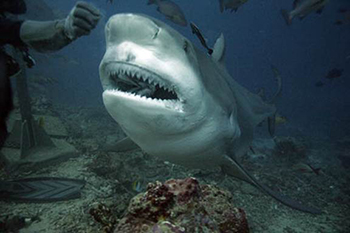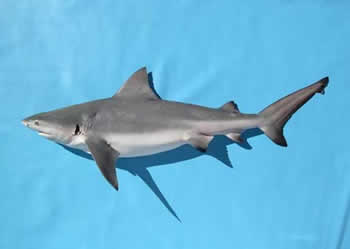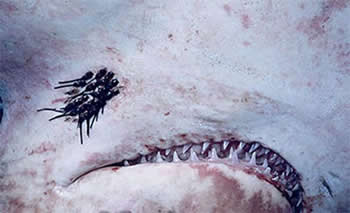Bull Shark
Carcharhinus leucas

Common name
Bull shark, Zambezi shark, Zambi, Nicaragua shark, Ganges River Shark, Fitzroy Creek Whaler, Van Rooyen’s Shark, Lake Nicaragua Shark, river shark, freshwater whaler, estuary whaler, Swan River Whaler, cub shark, shovel nose shark
Taxonomy
Kingdom Animalia
Phylum Chordate
Class Chondrichthyes
Subclass Elasmobranchii
Order Carchariniformes
Family Carcharinidae
Genus Carcharinus
Species: C. leucas
Identification
Bull sharks are known for their “bull-headed” look and territorial behaviors. The snout is very short; its mouth is wider than the snout is long. The first dorsal fin is high with a pointed tip; the second dorsal is much smaller. It have a dark gray on the back and white on the belly. The average male would be about 7 feet long and weight about 200 pounds. Females may be over 11 feet long and weigh about 500 pounds.

Life History
The first sharks, cladodonts, are believed to be coming from the warm oceans back in about 400 million years ago. The last species of cladodonts disappeared about 225 million years ago; by the end of the Cretaceous period (about 135-65 mya), there were sharks called the Carchariniformes just like today. (Blassingame, 1984).
Diet
Bull sharks eat a wide range of food, including rays, sea turtles, mammalian carrion, mantis shrimps, squids, crabs, sea urchins, sea snails and even garbage! (3. Anonymous, 2006). In the rivers, it has been known to kill hippopotamuses, terrestrial animals, including antelope, cattle, dogs, and humans. (Gold et al. 1989).
Habitat
They live around the world in many different areas; are common in the coastal areas of tropical shorelines, and occasionally in rivers and lakes where saltwater and freshwater flows together. They are the only sharks known to have a remarkable ability to thrive in both fresh and salt water where they can travel long distances in the rivers. (Gold et al. 1989). They can be found in the Ohio River in Indiana and Illinois, the Mississippi River, the Amazon River, the Rio San Juan and Lake Nicaragua, the Bombay River, the Zambezi River, the Congo River, the Brisbane River, Lake Jamoer and the Panama Canal. They enter freshwater for periods of up to several weeks. Breeding may be the reason they live in freshwater. Their excretory system is adapted to maintain their osmotic pressure at a level to prevent dehydration in both freshwater and saltwater, (Steel, 1985).

Yellow color = Bull Shark Range
( http://animals.nationalgeographic.com/animals/fish/bull-shark/ )
Reproduction
Bull sharks usually mate during late summer and early autumn in the water of river mouths. They are viviparous marine animals which born baby sharks, or pups, in much the same way as human beings and other mammals. A baby bull shark will be in gestation for 12 months before born. They are born fully developed, may be up to 4 feet long and ready to look after itself. They are often found in shallow bays and near the mouths of rivers. They may mature at 15 to 20 years, (Blassingame, 1984).
Behavior
Bull sharks are usually solitary hunters, but sometimes they do hunt in pairs. They can cruise through shallow waters with quick acceleration and high aggression toward other animals and humans. They are known for its unpredictable, often agile and aggressive behavior. Young sharks are often seen spinning out of the water, (Compagno et al. 2005). They are believed to be responsible for most attacks on humans much more than great white and tiger sharks, (Gold et al. 1989).
Recent research
A recent study conducted on bull shark’s vision found that their eyes aren’t designed to detect the different colors in water. They may only see everything in black and white. Their retinas had only one kind of cone (or light detector) that was only able to detect light or dark. Humans have 3 different cones to detect the separate colors: red, green, and blue. Brightness contrast is important for them to detect and identify objects, which leads to the misunderstanding on attacking people. Some claims the sharks thought people may be large kind of fish and bite for a taste to verify the object in their vision. From the International Shark Attack File (ISAF), the statistics shows that the majority of attacks happen to divers and surfers wearing black wetsuits. The recent finding may be useful to help design surf craft and swimming attire that are less attractive to sharks and reduce attacks on people. (Alleyne, 2011).
Economic/ecological service
- One or several bull sharks may have been responsible for the Jersey Shore shark attacks of 1916, which was the inspiration for Peter Benchley’s novel Jaws. The novel was then praised as one of the best and highest grossing movies ever directed by Steven Speilberg. (Blassingame, 1984).
- Frequently fishing for prizes and consumption by humans, bull shark meats can be eaten fresh, frozen or smoked, while the fins are popular in highly priced shark fin soups in China. Their hide with scales removed can be turned into leather. Their liver have oil rich in vitamin A. Their skin can be made as a large excellent fine sandpaper. Their teeth are popular for jewelry. It is listed as near threatened species on the Red List by the International Union for Conservation of Nature and Natural Resources, (3. Anonymous, 2006.)
- Saltwater crocodiles are sometimes found eating juvenile bull sharks in Australia. (Underwatertimes.com News Service, 2007).
- Copepods, the common ectoparasites, usually feed on the skin tissues of bull sharks, especially on the trailing surfaces of fins. The mutualistic symbiosis is believed to be the copepods’ action as a lure to attract prey, (Stevens, 1987).

( http://www.fingmonkey.com/2010/08/copepods-or-wtf-is-in-that-sharks-mouth.html )
Literature Cited
Compagno, Leonard, Dando, Marc, and Fowler, Sarah. Sharks of the World. Princeton: Princeton University Press, 2005. Print.
Blassingame, Wyatt. Wonders of Sharks. New York: Dodd, Mead and Company, 1984. Print.
Steel, Rodney. Sharks of the World. New York: Blandford Press Ltd, 1985. Print.
Stevens, John D. Sharks. New York: Facts on File, Inc., 1987. Print.
Gold, Joy P. and Springer, Victor G. Sharks In Question. Washington, DC: Smithsonian Institution Press, 1989. Print.
External links:
Please note that the following links may have either been removed or relocated by the webpage owners since the time this student report was created.
Anonymous. Animals: Nat Geo Wild: Bull Shark 2012. http://animals.nationalgeographic.com/animals/fish/bull-shark/ May 27, 2012
Anonymous. Animal Unique: Bull Shark. 2011. http://animal-unique.blogspot.com/2011/09/bull-shark.html May 27, 2012
Anonymous. Bull Shark. 2006. http://www.aquaticcommunity.com/sharkfish/bullshark.php May 31, 2012
Alleyne, Richard. The Telegraph: Sharks are colourblind new research finds. January 18, 2011. http://www.telegraph.co.uk/earth/wildlife/8266728/Sharks-are-colourblind-new-research-finds.html May 30, 2012
Underwatertimes.com News Service. August 13, 2007. http://www.underwatertimes.com/news.php?article_id=84173256109 May 29, 2012